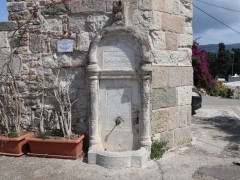Turkish domination

The Turkish period on Kos, which lasted from 1522 to 1912, represents a long and important chapter in the history of the Greek island. After the departure of the Knights of St John (Johanites), the island became part of the Ottoman Empire, which brought new changes in political administration, religion, culture and the daily life of the inhabitants.
Arrival of the Ottoman Empire
At the turn of 1522 / 1523, after the fall of Rhodes, the Ottoman Empire under Sultan Suleiman the Magnificent took control of the island of Kos and other Aegean islands. The Ottoman Empire, which at that time was expanding into Europe, Asia and Africa, included Kos in its provinces. The island became a strategic point in the Aegean due to its location on the trade routes between East and West and its proximity to Asia Minor.
Administration and life under Ottoman rule
Under Ottoman rule, Kos was incorporated into the wider administrative system of the empire. The island was administered by a local governor, who was appointed by the Sultan, and administratively fell under the administration of the Sanjak of Rhodes, a smaller administrative unit within the larger province. The local governor was responsible for collecting taxes, maintaining order, and providing for the island's defense.
The local inhabitants, mostly Greek Orthodox Christians, had limited autonomy but were allowed to retain their religion and customs in exchange for paying a special tax known as the "hara├ž" or "jizya". This tax was seen as the price for protection and religious freedom under Muslim rule.
During the Ottoman period, several Muslim families also settled on the island, leading to the creation of a small but significant Muslim community. These new inhabitants brought their own cultural and religious traditions to Kos, leading to the establishment of new mosques, public baths (hammams), schools (madrasas) and other buildings associated with Islamic culture. Among the most important buildings are the Defterdar Mosque and the Gazi Hassan Pasha Mosque.
Economic development and trade
The Ottoman period brought stability to Kos, which encouraged economic development and trade. The island was located on important maritime routes between East and West, allowing it to benefit from trade and shipping. Agriculture, crafts and manufacturing developed during this time. The island of Kos was famous for its agricultural products such as olives, wine, grain and fruit, which were exported to various parts of the Ottoman Empire.
The course and end of Ottoman rule
In the 17th and 18th centuries the island faced several Venetian and Maltese raids. The Turkish garrison on the island was reinforced and new fortresses were built. During the Greek War of Independence of 1821-1829, Kos remained under Ottoman control, but the sympathies of the local Greek population were on the side of the rebels.
The 19th century saw a gradual decline of Ottoman power, which was reflected in Kos. The Greek population gained more influence in the local administration and economy.
Ottoman rule on Kos ended in 1912 during the Italo-Turkish War, when Italy took control of the island as part of its expansion in the Aegean. This end of Turkish rule marked the beginning of a new chapter in the island's history, when Kos came under Italian administration and later became part of modern Greece.
Although Turkish rule ended, part of the Muslim population remained on the island until the exchange of population between Greece and Turkey in 1923.
Sights
The Ottoman rule left several important monuments on the island of Kos that still commemorate this period. Ottoman architecture on the island is characterised by distinctive features such as minarets, arches, fountains and richly decorated interiors.
Defterdar Mosque: The mosque, located in Eleftherias Square in the capital of Kos, was built at the end of the 18th century. It is named after the Ottoman governor of the island, Defterdar, who had it built. The mosque is an important example of Ottoman architecture and is still one of the main monuments of the Ottoman period on the island.
Gazi Hassan Pasha Mosque (Loggia): The mosque was built in the 18th century and named after the Ottoman admiral Gazi Hassan Pasha. It is located in Platanos Square in the capital of Kos. The mosque is famous for its beautiful architecture and the minaret that dominates the square.
Ottoman burial grounds and mausoleums: There are several Ottoman burial sites and mausoleums on the island. The tombs are often decorated with inscriptions and ornaments.
Did you visit this place and do you have some additional informations, interessting observation or photos?


